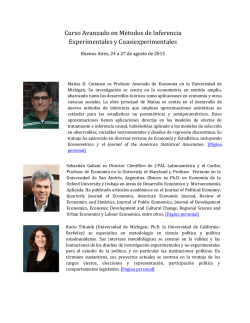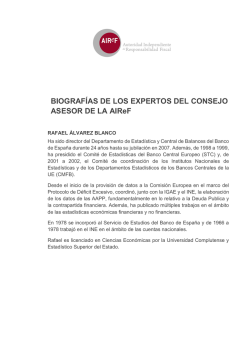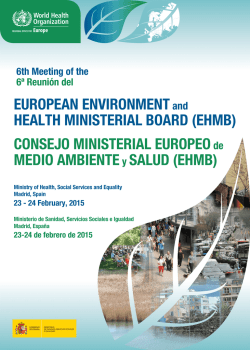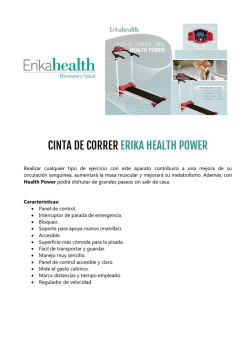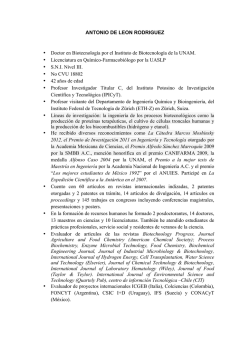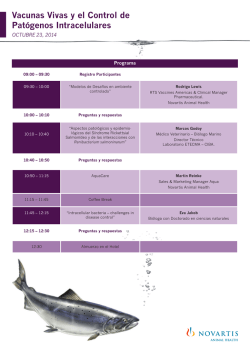
Curso de Economía de la Salud Pública
Curso de Economía de la Salud Pública Fechas: 23 a 26 de junio de 2015 Horario: 9:00 a 13:00 horas Sede: Fundación Ramón Areces (Calle Vitrubio 5, Madrid) Profesor: Roger Feldman, Profesor de la Escuela de Salud Pública de la Universidad de Minnesota E-mail: [email protected] I. Descripción del curso El curso analiza los temas que surgen en la intersección entre Salud Pública y Economía. Utiliza la teoría económica para analizar los principales problemas de salud pública causados por el comportamiento individual y y discute las soluciones para estos problemas basadas en el mercado y en la acción del gobierno. II. Conocimientos previos Unos conocimientos básicos de Microeconomía son útiles para seguir el curso, aunque no imprescindibles. Se explicarán los conceptos económicos básicos, según sea necesario durante el curso. III. Objetivos Mejorar la compresión de los principios económicos que se relacionan con los principales problemas de salud pública, como obesidad, tabaquismo y comportamientos de riesgo. o Fallos de Mercado y otros problemas de información que provocan problemas de salud pública o El papel de las soluciones basadas en el mercado, o El papel de las soluciones basadas en la intervención del gobierno Explicar cómo utilizar el análisis económico para evaluar las propuestas de reforma para mejorar la salud pública. IV. Desarrollo del curso Los alumnos deben leer previamente a las clases las lecturas asignadas y estar preparados para su discusión. El tiempo de clase de dedicará tanto a explicación como a discusión. Las clases se impartirán en inglés. V. Documentación del curso Este es un curso basado en lecturas disponibles en Internet con libre acceso. En los pocos casos en que no sea así se proporcionará una copia a los alumnos. 1 VI. Programa y lecturas Tema 1: introducción a la Economía de la Salud Pública. Vilma Carande-Culis, Thomas Getzen, and Stephen Thacker, “Public Goods and Externalities: A Research Agenda for Public Health Economics,” Journal of Public Health Management Practice, 3:2 (2007), 227-232. Paul Samuelson, “A Pure Theory of Public Expenditure,” Review of Economics and Statistics, 36 (1954), 387-389. Emmett Keeler, et al., “The External Costs of a Sedentary Lifestyle,” American Journal of Public Health, 79:8 (1989), 975-981. Edwin Fujii, “On the Value of Information on Product Safety: An Application to Health Warnings on the Long Run Medical Implications of Cigarette Smoking,” Public Finance, 30 (1975), 323-332. Monique Muggli, et al., “Legislating Tolerance: Spain’s National Public Smoking Law,” Tobacco Control, 19 (2010), 24-30. Maria Lόpez, et al., “Two-year Impact of the Spanish Smoking Law on Exposure to Secondhand Smoke: Evidence of the Failure of the ‘Spanish Model’,” Tobacco Control, 21 (2012), 407-411 Maria Lόpez, et al., “Impact of the 2011 Spanish Smoking Ban in Hospitality Venues: Indoor Secondhand Smoke Exposure and Influence of Outdoor Smoking,” Nicotine & Tobacco Research, 15:5 (2013), 992-996. Tema 2: obesidad. Roland Sturm, “The Effects of Obesity, Smoking, and Drinking on Medical Problems and Costs,” Health Affairs, 21:2 (March, 2002), 245-253. Katherine Flegal, et al., “Prevalence and Trends in Obesity among US Adults, 1999-2008,” JAMA, 303:3 (2010), 235-241. JR Banegas, et al., “A Simple Estimate of Mortality Attributable to Excess Weight in the European Union,” European Journal of Clinical Nutrition, 57 (2003), 201-208. Joan Costa-Font and Joan Gil, “What Lies Behind Socio-demographic Inequalities in Obesity in Spain: A Decomposition Approach,” Food Policy, 33 (2008), 62-73. Nicholas Christakis and James Fowler, “The Spread of Obesity in a Large Social Network Over 32 Years,” New England Journal of Medicine, 357 (July 26, 2007), 370-379. David Cutler, Edward Glaeser, and Jesse Shapiro, “Why Have Americans Become More Obese?” Journal of Economic Perspectives, 17:3 (2003), 93-118. 2 Hayley Chouinard, et al., “Fat Taxes: Big Money for Small Change,” Forum for Health Economics & Policy, 10:2 (June, 2007), 1-28. Y. Claire Wang, et al., “A Penny-Per-Ounce Tax on Sugar-Sweetened Beverages Could Cut Health and Cost Burdens of Diabetes,” Health Affairs, 31:1 (2012), 199-207. Jason Fletcher, David Frisvold, and Nathan Teft, “Can Soft Drink Taxes Reduce Population Weight?” Contemporary Economic Policy, 28:1 (2010), 23-35. K. Brownell and T. Frieden, “Ounces of Prevention: The Public Policy Case for Taxes on Sugared Beverages,” New England Journal of Medicine, 360 (April 30, 2009), 1805-1808. S. Chou, H. Saffer, and M. Grossman, “An Economic Analysis of Adult Obesity: Results from the BRFSS” Journal of Health Economics, 23:2 (May, 2004), 565-587. Tema 3: acoso escolar y otros comportamientos violentos y efectos de grupo social Charles Manski, “Identification of Exogenous Social Effects: The Reflection Problem,” Review of Economic Studies, 60 (1993), 531-542. Andrew Clark and Youenn Lohéac, “’It Wasn’t Me, It Was Them!’ Social Influence in Risky Behavior by Adolescents,” Journal of Health Economics, 26 (2007), 7763-784. Toni Mora and Joan Gil, “Peer Effects in Adolescent BMI: Evidence from Spain,” Health Economics, 22 (2013), 501-516. Michael Kremer and Dan Levy, “Peer Effects and Alcohol Use Among College Students,” Journal of Economic Perspectives, 22:3 (2008), 189-206. Sarah Brown and Karl Taylor, “Bullying, Education, and Earnings: Evidence from the National Child Development Study,” Economics of Education Review, 27 (2008), 387-401. Mattias Persson and Mickael Svensson, “The Willingness to Pay to Reduce School Bullying,” Economics of Education Review, 35 (2013), 1-11. Tema 4: decisions inadecuadas o irracionales Kevin Volpp, et al., “Financial Incentive-Based Approaches for Weight Loss: A Randomized Trial,” JAMA, 300:22 (December 10, 2008), 2631-2637. Harrell W. Chesson, et al., “Discount Rates and Risky Sexual Behaviors among Teenagers and Young Adults,” Journal of Risk and Uncertainty, 32 (2006), 217-230. Tema 5: vacunas M. Kremer, “Creating Markets for New Vaccines, Part I,” Innovation Policy and the Economy, 1 (2000), 35-72. 3 John Mullahy, “It’ll Only Hurt a Second: Microeconomic Determinants of Who Gets Flu Shots,” Health Economics, 8 (1999), 9-24. Steven Parente, David Salkever and Joan DaVanzo, “The Role of Consumer Knowledge of Insurance Benefits for Preventive Health Care Among the Elderly,” Health Economics, 14:1 (2005), 25-38. Paul Hebert, et al., “The Causes of Racial and Ethnic Differences in Influenza Vaccination Rates Among Elderly Medicare Beneficiaries,” Health Services Research, 40:2 (2005), 517-537. Jürgen Maurer, “Who Has a Clue on Preventing the Flu?” Journal of Health Economics, 28:3 (2009), 704-717. The Editors, “Wakefield’s Article Linking MMR Vaccine and Autism Was Fraudulent,” BMJ, 342 (January 8, 2011), 64-67. The Editors, “Improving Uptake of MMR Vaccine,” BMJ, 336 (April 5, 2008), 729-730. Cate Wallace, Julie Leask, and Lyndal Trevena, “Effects of a Web Based Decision Aid on Parental Attitudes to MMR Vaccination: A Before and After Study,” BMJ, 332 (January 19, 2006), 146-149. Tema 6: seguridad en el tráfico vial Josep Ferrando, et al., “Impact of a Helmet Law on Two Wheel Motor Vehicle Crash Mortality in a Southern European Urban Area,” Injury Prevention, 6 (2000), 184-188. Alma Cohen and Liran Einav, “The Effects of Mandatory Seat Belt Laws on Driving Behavior and Traffic Fatalities,” Review of Economics and Statistics, 85:4 (November, 2003), 828-843. Thomas S. Dee, “Does Setting Limits Save Lives? The Case of 0.08 BAC Laws,” Journal of Policy Analysis and Management, 20:1 (2001), 111-128. Richard Thaler and Sherwin Rosen, “The Value of Saving a Life: Evidence from the Labor Market,” in Household Production and Consumption, ed. by N.E. Terleckyj, New York: Columbia University Press for the National Bureau of Economic Research, 1975. Frank Sloan, et al., Drinkers, Drivers, and Bartenders, Chicago: University of Chicago Press, 2000. Tema 7: violencia armada John Lott and David Mustard, “Crime, Deterrence, and Right-to-Carry Concealed Handguns,” Journal of Legal Studies, 26:1 (January, 1997), 1-68. Hashem Dezhbakhsh and Paul Rubin, “Lives Saved or Lives Lost? The Effects of Concealed-Handgun Laws on Crime,” American Economic Review, 77: 2 (1998), 468-474. Mark Duggan, “More Guns, More Crime,” Journal of Political Economy, 109:5 (2001), 1086-1114. John Donohue and Steven Levitt, “The Impact of Legalized Abortion on Crime,” Quarterly Journal of Economics, 106:2 (May, 2001), 379-420. 4 Tema 8: comportamientos adictivos y juegos de azar. Gary Becker, Michael Grossman, and Kevin Murphy, “Rational Addiction and the Effect of Price on Consumption,” American Economic Review, 81:2 (1991), 237-241. Michael Grossman and Frank Chaloupka, “The Demand for Cocaine By Young Adults: A Rational Addiction Approach,” Journal of Health Economics, 17 (1998), 427-474. John Conlisk, “The Utility of Gambling,” Journal of Risk and Uncertainty, 6 (1993), 255-275. John Nyman, John Welte, and Bryan Dowd, “Something for Nothing: A Model of Gambling Behavior,” Journal of Socio-Economics, 37 (2008), 2492-2504. 5 VII. Información Adicional Lecturas adicionales Pueden enviarse durante el curso lecturas adicionales, como material para discutir en clase. Los asistentes pueden buscar artículos de noticias relacionadas con los temas tratados, para ello se deben enviar previamente por correo electrónico al profesor, para que esté a disposición de todos los alumnos, además se puede hacer una breve presentación que resuma el artículo y su relación con los temas estudiados. También pueden ser artículos en español. Se anima a sugerir lecturas para cada tema. . VIII. Admisión La admisión al curso es decidida por la organización previa solicitud. Applications should be sent by email: [email protected], enclosing CV and application form The course is free. 6
© Copyright 2024
